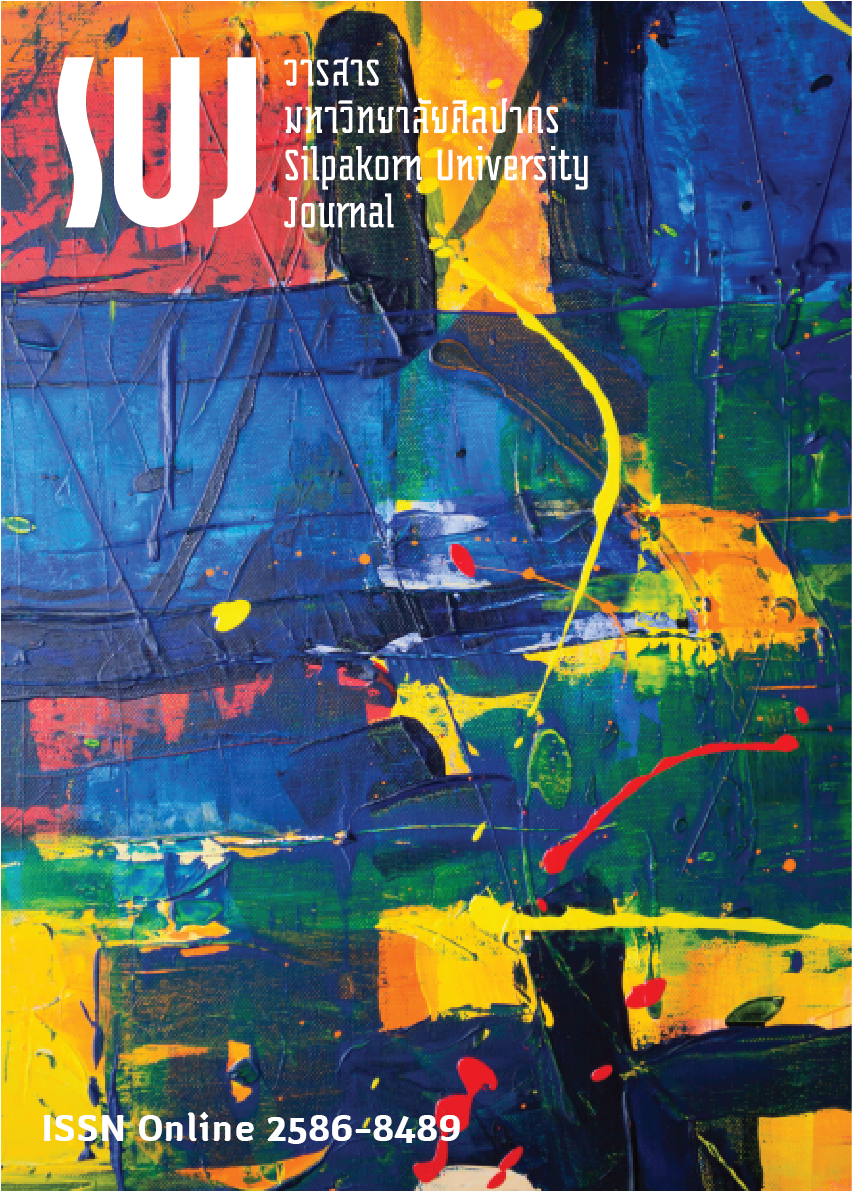รูปแบบการตัดสินใจใช้บริการแอพพลิเคชั่น “วงใน” ในกรุงเทพมหานคร (Model of decision to use the Wongnai application service in Bangkok)
Main Article Content
Abstract
งานวิจัยนี้มีวัตถุประสงค์เพื่อศึกษาระดับปัจจัยที่มีผลต่อการตัดสินใจใช้บริการแอพพลิเคชั่น “วงใน” ในกรุงเทพมหานคร และศึกษาความสัมพันธ์โครงสร้างเชิงสาเหตุของรูปแบบการตัดสินใจใช้บริการแอพพลิเคชั่น “วงใน” ในกรุงเทพมหานคร กลุ่มตัวอย่าง ได้แก่ ผู้ใช้บริการแอพพลิเคชั่น “วงใน” ในกรุงเทพมหานคร จำนวน 400 ตัวอย่าง การศึกษาครั้งนี้ใช้แบบสอบถามเป็นเครื่องมือเก็บข้อมูล สถิติที่ใช้วิเคราะห์ข้อมูล ได้แก่ ค่าความถี่ ค่าร้อยละ ค่าเฉลี่ยเลขคณิต ค่าเบี่ยงเบนมาตรฐาน ส่วนสถิติที่ทดสอบสมมติฐาน ได้แก่ การวิเคราะห์เส้นทางอิทธิพล (path analysis) และการวิเคราะห์โมเดลสมการโครงสร้าง (Structural Equation Modeling: SEM) จากการศึกษาพบว่า 1) ปัจจัยด้านการสื่อสารทางการตลาดดิจิทัล การยอมรับการใช้เทคโนโลยีมีผลทางตรงและทางอ้อมต่อการตัดสินใจใช้บริการแอพพลิเคชั่น “วงใน” ในกรุงเทพมหานคร และ 2) โมเดลความสัมพันธ์เชิงสาเหตุที่พัฒนาขึ้นจากการวิจัยมีความเหมาะสม เนื่องจากมีความสอดคล้องกับข้อมูลเชิงประจักษ์ และแต่ละองค์ประกอบของโมเดลมีความเที่ยงตรง มีความสามารถในการพยากรณ์ได้ในระดับดีและเป็นที่ยอมรับได้
The purposes of this research were to study levels of factors affecting the decision to use the Wongnai application service in Bangkok and to study the structural equation modeling of causal factors on the decision to use the Wongnai application service in Bangkok. Samplings were 400 people. Questionnaires were used to collect data. The data received were calculated and analyzed by using descriptive statistics (frequency, percentage, mean and standard deviation). The path analysis was used to test the hypotheses. The structural equation modeling (SEM) was used to test the decision to use the Wongnai application service in Bangkok. The findings revealed that 1) a factor of a digital marketing communication- an acceptance of using technology affects both directly and indirectly in terms of decision making for deploying the Wongnai application service and 2) the developed causal model was appropriate since they were consistent based on an empirical data. Elements of the model were accurate (validity) and acceptable with a good predictive ability level.
Article Details
References
Colliers International Thailand Research. (2017). Market Report: Bangkok Retail 2Q/2017. Retrieved December 26, 2018 from https://www.colliers.com/en-th/thailand
Davis, R. P. Bangozzi. (1989). User Acceptance of Computer Technology: A Comparison of two Theoretical Models. Management Science, 35(8): 982-1002.
Den Hertog, P. (2000). Knowledge-intensive business services as co-producers of innovation. International Journal of Innovation Management, 4(4): 491-528.
Den Hertog, P. (2010). Managing service innovation: firm-level dynamic capabilities and policy options. Utrecht: Dialogic Innovate.
Etzel, M. J., Walker, B. J., & Stanton, W. J. (2001). Marketing management. Boston, MA.: McGraw-Hill.
Kotler, P (1999). Marketing management analysis, planning and control. (10th ed.). New Jersey: Prentice Hall.
Kim, C., Tao, W., Shin, N., & Kim, K. (2010). An empirical study of customer’s perception of security and trust in e-payment systems. Electronic Commerce Research and Applications, 9(1): 84-95.
Kulthakornsate, Nattek. (2015). The Structural Equation Model of Causal (รูปแบบความสัมธ์โครงสร้างเชิงสาเหตุของปัจจัยที่ส่งผลต่อกลยุทธ์การตลาด สำหรับธุรกิจแฟชั่นเครื่องนุ่งห่มไทยสู่ตลาดประชาคมเศรษฐกิจอาเซียน). Journal of Business Economics and Communications, 10(2): 145-165.
Limratchadamon S. (2017). Trend of Eating Out (ส่องเทรนด์ ‘ทานอาหารนอกบ้าน’). Retrieved December 26, 2018 from https://www.bangkokbiznews.com/news/detail/776700
Izogo, E. (2015). Determinant of attitudinal loyalty in Nigeria telecom services sector: does commitment play a mediating role. Journal of Retail and Consumer Services, 23: 107-117.
Oliveira, T. & Martins, M. F. (2011). Literature Review of Information Technology Adoption Models at Firm Level. The Electronic Journal Information Systems Evaluation, 14(1): 110-121.
Puttum, Rampaipan. (2014). Marketing communication affecting consumers’ buying decision in Central Department Store Chaeng Watthana Branch (การสื่อสารทางการตลาดที่มีผลต่อพฤติกรรมการตัดสินใจซื้อสินค้าของผู้บริโภคในห้างสรรพสินค้าเซ็นทรัลสาขาแจ้งวัฒนะ). Graduate school journal, Durakit Bundit University, 3(2): 188-196.
Robbins, S. P. (1994). Management (6th ed). USA: Prentice-Hall.
Salter, A., & Tether, B. S. (2006). Innovation in services. Through the looking glass of innovation studies. London: Tanaka Business School, Imperial College.
Vanichbuncha, Kanlaya. (2014). Structure Equation Modeling (SEM) by AMOS (การวิเคราะห์สมการโครงสร้าง (SEM) ด้วย AMOS). (1st ed.). Bangkok: Chulalongkorn Printing.

